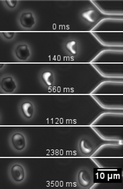Hydrodynamic deformation reveals two coupled modes/time scales of red blood cell relaxation
Abstract
We study the mechanical relaxation behavior of human red blood cells by observing the time evolution of shape change of cells flowing through microchannels with abrupt constrictions. We observe two types of relaxation processes. In the first fast process (τ1 ∼ 200 ms) the initially parachute shaped cells relax into cup-shaped cells (stomatocytes). These cells relax and reorient in a second relaxation process with a response time of τ1/2 ∼ 10 s into the equilibrium discoid shapes. The values for the relaxation times of single red blood cells in the population scatter significantly within the cell population between 0.11 s < τ1 < 0.52 s and 9 s < τ1/2 < 49 s, respectively. However, when plotting τ1/2 against τ1, we find a linear relationship between the two timescales and are able to relate both to the elastic properties of the spectrin cytoskeleton underlying the red cell's plasma membrane.


 Please wait while we load your content...
Please wait while we load your content...